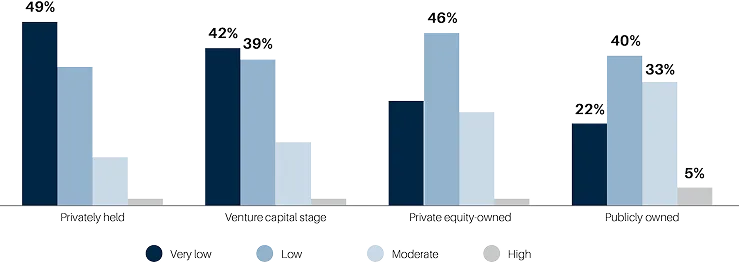
AI is no longer a question of “if,” but of readiness
This article is an excerpt from Riviera Partners’ Future of Tech Leadership 2025 report, based on insights from more than 1,000 senior technology leaders. Download the full report for complete data, charts, and frameworks.
The strategic importance of AI vs. the readiness reality
AI has moved from possibility to priority. In our survey of 1,038 senior tech leaders, 62% said AI is “very important” to enterprise strategy in the next 12–18 months. Yet when asked whether their leadership was prepared to execute at scale, only 58% agreed.
This gap between ambition and readiness is defining the next era of tech leadership. It’s no longer enough to experiment with copilots or pilot projects; companies need the structures, leaders, and cultural scaffolding to sustain AI adoption.
Not all industries are approaching AI readiness at the same pace. Tech companies are the most likely to fall into the very low readiness tier, with 38% struggling to put the right foundations in place.

See how your org measures up—download the full report of 1,000+ tech leaders.
“Only 2% of companies are structurally AI-ready.”
The AI organizational readiness crisis
Riviera’s proprietary Organizational Design Readiness Index quantified just how underprepared most companies are. The findings:
- Only 2% of companies rank as “high readiness.”
- 77% fall into low or very low readiness.
- Venture-backed and privately held firms are most exposed, with 42% and 49%, respectively, in the very low readiness tier.

Where companies are falling short
When asked what’s holding them back, leaders pointed to three consistent gaps:
- Change management & execution discipline (42%)
- AI fluency across leadership (35%)
- Strategic agility (35%)
These aren’t purely technical barriers — they’re organizational ones. Without strong executive discipline and clarity of ownership, even early adopters with sophisticated AI pilots struggle to scale effectively.
High-readiness companies show what’s possible
While rare, companies that scored high on the Readiness Index offer a roadmap. Compared to their peers, they are:
- 3x more likely to create AI-specific executive roles (64% vs. 21%)
- Far more likely to report a Chief AI Officer (72% vs. 21%)
- Implementing more hiring and team development strategies on average (2.5 vs. 1.2)
FAQ: Why readiness is the new differentiator
Every company is buying AI tools, but few are building the leadership and organizational muscle to use them effectively. As a result, a competitive divide is opening: Companies that experiment vs. companies that execute.
This article is an excerpt from Riviera Partners’ Future of Tech Leadership 2025 report, based on insights from more than 1,000 senior technology leaders. To explore the full findings, charts, and frameworks, download the complete report here.
Want to know where your company stands? Take our AI Organizational Readiness Quiz to get your custom score and see how you compare to peers across VC, PE, and public companies.
Next Up → Explore how leadership hiring is changing in 2025
Back to → The Future of Tech Leadership